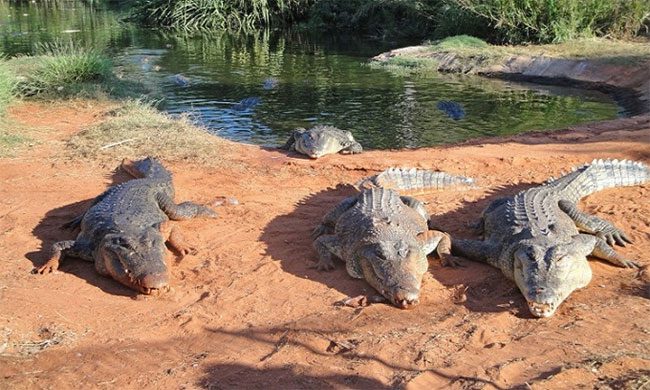Researchers are exploring ways to introduce emetic chemicals into cane toads to teach freshwater crocodiles not to eat this toxic invasive species.
Cane toads are poisoning freshwater crocodiles as they continue to spread across the Kimberley region of Western Australia. However, in Windjana Gorge National Park, researchers are preparing to combat mass mortality events by treating cane toad carcasses with emetic chemicals to train native crocodiles to steer clear of this harmful creature, the Guardian reported on September 24.

Freshwater crocodile in Kimberley. (Photo: The Kimberly Australia)
As the dry season in Kimberley lasts from September to October and rivers turn into puddles, crocodiles across the river systems gather in large numbers, according to Dr. Georgia Ward-Fear, an ecologist at Macquarie University. The scarcity of food makes crocodiles hungrier in the heat, while cane toads are also seeking water. When the ranges of the two species overlap, crocodiles are at risk of mass mortality since they are all in the same area.
Cane toads were introduced to Australia nearly 100 years ago as a pest control method in Queensland. Carrying toxins, they have started to spread from northern to western Australia. Top native predators that typically prey on frogs, such as freshwater crocodiles, monitor lizards, snakes, and quokkas, attempt to eat cane toads and are killed by their toxins. Last year, 60 freshwater crocodiles were poisoned and killed by cane toads in Danggu Gorge in Kimberley.
Cane toads are expected to invade the town of Derby this year. By 2025, they will spread throughout Broome. Once cane toads take over Kimberley, the population of top predators is likely to decline significantly. This will impact the entire food chain. Conventional invasive species management methods include manual capture or fencing. However, with female toads laying 30,000 eggs and producing two clutches a year, no method is truly effective in slowing the invasion rate or reducing the cane toad population in the environment.
Instead, Ward is studying at-risk native species and focusing on mitigating the damage. She is leading a study at Macquarie University in Windjana Gorge, where experts take the intestines of euthanized cane toads, inject them with a non-lethal salt compound, and use them as bait for freshwater crocodiles. If the crocodiles consume the bait, they will vomit and learn that cane toads are harmful.
Nicki Mitchell, an associate professor at the University of Western Australia, remarked that modifying the behavior of native animals to avoid the toxins of cane toads in the future is “an excellent initiative.” If implemented on an appropriate scale, predators will be less likely to consume cane toads they encounter.
Technical officer Miles Bruny shared that before deploying bait along the riverbanks, they must handle hundreds of toads, including removing toxic parts such as the stomach and eggs from female toads. The research team needs to place the toad carcasses in water areas just before sunset to prevent other animals nearby from eating the bait. The following morning, they will collect data by canoeing or walking. “It’s not an easy job. We may not save every crocodile, but we are conserving the population and their diversity,” Bruny said.





















































